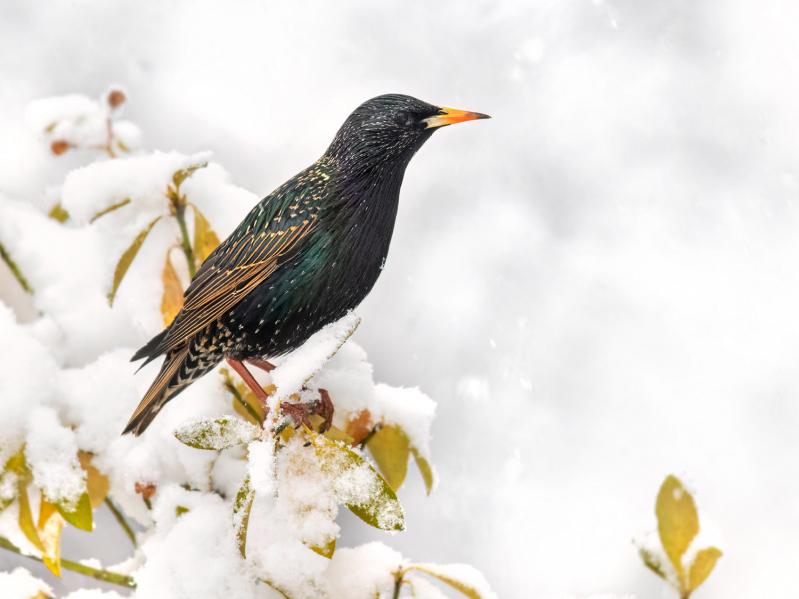In describing the meaning of his song “Hallelujah,” Leonard Cohen said, “The world is full of conflicts and full of things that cannot be reconciled. But there are moments when we can reconcile and embrace the whole mess, and that’s what I mean by ‘Hallelujah.’ ”
I’m not sure if he was into birds, but if he was, he might have appreciated the mess that is the European starling.
The more you know about this invasive but fascinating bird, the more ambivalent it will make you feel. It starts by having a troubled history, through no fault of its own, other than its ability to adapt.
It was introduced to the United States in 1890, when 80 were released in Central Park by Eugene Schieffelin, an amateur ornithologist who, decades earlier, had introduced another pest, the house sparrow.
Schieffelin had the misguided idea that Americans should be able to appreciate all the birds mentioned by Shakespeare with their feet firmly planted in the United States.
He wasn’t thinking, “Oh, maybe introducing this aggressive European bird might affect the ecological order in the United States.” Apparently, he was only thinking, “Shakespeare good.”
Of the 38 plays he authored, Shakespeare mentioned them exactly once, in “Henry IV.”
“Other birds he tried to introduce just didn’t survive,” said Paul Cabe, a professor of biology at Washington and Lee University, and a starling expert. But boy did the starlings take hold!
Ornithologists now estimate there are 200 million European starlings in the United States.
Until recently, I hated them. They have a reputation for being nasty to our native birds who, like them, nest in tree cavities. Our state bird, the Eastern bluebird, and many species of woodpeckers, have had their homes invaded and stolen by starlings. But they’re also incredibly adaptable, and nest in nooks and crannies in our villages and cities that are not used by native birds.
Shakespeare fanboy Schieffelin might be thrilled to know that a couple nest in holes in Bay Street Theater in Sag Harbor.
At least one starling nests in a utility pole at Sag Harbor’s Mashashimuet Park that is surrounded by bluebird boxes. In the last 130 years we have learned that bluebirds can fit into a one-and-a-half-inch hole that is too small to allow starlings. Unfortunately, Schieffelin’s other successful introduction, the house sparrow, aggressively displaces bluebirds since it can squeeze into smaller openings.
Mr. Cabe said it is difficult to blame starlings for the loss of woodpeckers and bluebirds. “They’re not doing more damage than we are, that’s for sure!”
In fact, according to allaboutbirds.org, “A study in 2003 found few actual effects on populations of 27 native species. Only sapsuckers showed declines due to starlings; other species appeared to be holding their own against the invaders.”
Here are birds that benefit from our obsession with sod: They eat insects hiding in short grass. But they’re omnivorous. “They’re adaptable to food,” said Mr. Cabe. If you throw a bagel on your lawn, they’ll eat that too. They stalk around purposefully when hunting, looking like an old man bent from the waist as they go, usually in a group.
Take a quick glance and you may think they’re black but look closely when they enter breeding plumage in the spring, and you’ll see rainbows in their iridescent feathers. When they molt in the fall, they have white spots. They’re slightly smaller than a robin. In flight they’re easy to spot because they have very short tails and wings that form perfect triangles when they coast. They’re often in large communal groups, even during the breeding season, unlike other birds, which maintain more distance from one another.
They sing, but you wouldn’t call it a song. It’s more like a conversation. These birds are mimics, and you’ll find some fascinating viral videos of starlings trained to say all sorts of things. Another viral starling video speaks to their ability to nest just about anywhere: Search “bird scares friends” to see what I meanThese aren’t hard birds to find. On our highways, they line our signs. A birder in Sayville counted more than 13,000 entering a night roost. We tend to focus on a bird’s individual characteristics that make it beautiful. However, the huge (yes, potentially problematic) population of starlings creates a communal phenomenon called a murmuration that’s otherworldly. One more starling-inspired thing to search for on YouTube.
You can be assured of seeing them on the north end of Main Street in Sag Harbor, and a stroll around Vineyard Field behind the South Fork Natural History Museum in Bridgehampton will also usually produce a handful. The inlet at Lake Montauk is another starling hangout.
I start my mornings with starlings. Crossing Bay Street from Long Wharf to get my coffee at Grindstone, I pass under a black rainbow of starlings chatting wing to wing on an electrical wire.
So instead of looking askance at these birds, I’ve started to appreciate them. I’ve embraced their complexity.
This past weekend I spent the first hour of sun at Mashashimuet and watched 10 very American robins listening to the grass for earthworms. Within their group were two European starlings, a long way from home but doing their best to mix with the locals, and pulling it off. High above on a light pole another sat, whistling from a vacant osprey nest.
They’re complex, but hallelujah, they’re somehow thriving in our world. Might as well get used to them.

